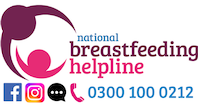1. When is the pain at its worst?
Before a feed or during the night – breast not being emptied properly – ducts become over distended. This may also be a symptom of unresolved engorgement. To address this improve attachment and feed frequently to drain both breasts effectively.
During a feed – if the pain lasts for more than 5 seconds it is likely that positioning and attachment are not as good as they could be. Have someone observe full feed, regardless of what appears to be a good latch; pain indicates that something is wrong.
After every feed, lasting for up to an hour – possibly thrush
2. How severe is the pain?
Thrush tends to be extremely painful after every feed, not just uncomfortable after some feeds.
3. Is the pain in both breasts?
Thrush soon transfers from one breast to the other; pain is generally felt on both breasts except in the very early stages. If the pain affects only one breast and is experienced during the feed positioning and attachment on that breast should be optimised.
4. How old is the baby?
Thrush in the first few weeks of feeding should be rare unless the mother had vaginal thrush at delivery or had deep breast thrush at the end of a previous lactation. Less than perfect positioning and attachment with consequent damage are more likely to cause the pain at this stage.
5. What does the nipple look like when a feed finishes?
If there is any flattening of the nipple from top to bottom or side to side positioning and attachment should be considered first. If even skilled help does not improve the nipple shape tongue-tie should be considered.
6. Is there any change in colour of the nipple or areola?
Thrush can cause a reddening of the nipple (which might not be easily visible on all skin tones) and loss of colour in the areola. Temporary loss of colour which returns to normal within a couple of seconds does not suggest thrush but maybe due to incorrect positioning or Reynaud’s syndrome. Some mothers are aware that they always have cold extremities, reinforcing the likelihood of this as a cause of pain.
7. Can the mother point to a specific area from which the pain radiates?
There may be a white spot visible on the nipple, at the point which indicates a blockage in that duct and build up of pressure behind it. This causes “pin-point” pain which can be very severe. Removal of the blockage with a sterile needle or gentle rubbing may resolve the pain for a period but it is likely to re-occur. The pain can be very severe.
8. What other symptoms does the mother have?
Thrush does not produce a fever, a red area on the breast or a yellowy discharge from the nipple. Skin may be sore but should not be excessively dry. If the baby has plaques in his/her mouth the mother may exhibit no symptoms but should be treated topically with the cream to prevent re-infection of the baby.
Thrush should be a diagnosis of exclusion, particularly after position and attachment have been optimised by an experienced breastfeeding worker.
Exposing mother and baby to topical or oral treatments unnecessarily is unethical and unfair for two reasons:
- It may delay resolution of the true cause of the nipple pain
- It necessitates the healthcare professional who prescribes or sells the medication outside of its license application to take responsibility for the use of the product.
We would strongly discourage use of medication until positioning and attachment have been thoroughly explored by someone skilled in breastfeeding attachment difficulties.
We also suggest that treatment is not commenced whilst waiting for difficulties such as tongue tie to be addressed.
The use of these medications during breastfeeding, whilst safe if used effectively, should not be used in a way which is likely to encourage resistance to anti-fungals to develop. Mothers and babies should not be exposed inappropriately.
NB. If any healthcare professional or volunteer recommends the use of fluconazole and miconazole to a mother, or diagnoses thrush of the lactating breast, they do so under their own levels of responsibility/ code of conduct. We would like to make it clear that neither BfN or Wendy Jones (pharmacist who compiled the medical information) can be held responsible for use nor for any adverse effects which may be suffered by the mother or baby.
Please read If Breastfeeding Hurts for more detailed information.
©Dr Wendy Jones MBE, MRPharmS and the Breastfeeding Network Sept 2019

